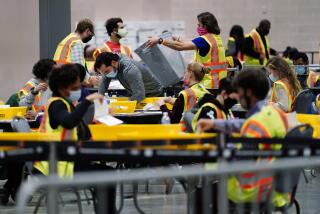Judges Divided Over Redistricting Measure
- Share via
SACRAMENTO — A panel of three state appeals court justices appeared divided Friday over whether to allow a ballot proposition that is a key element of Gov. Arnold Schwarzenegger’s agenda to remain on the Nov. 8 special election ballot.
With the printing of 12 million voter guides scheduled to begin Aug. 15, the 3rd District Court of Appeal is expected to rule by Tuesday. Any decision is likely to be appealed quickly to the state Supreme Court.
At stake is Proposition 77, which attempts to strip politics from the once-a-decade job of drawing legislative and congressional districts by giving the task to a panel of retired judges.
Lawmakers now map districts, and the lines they drew in 2001 cluster Democratic and Republican voters to make reelection a safe bet for incumbents. Retired judges, Schwarzenegger has said, will draw more compact, competitive districts that he argues would make lawmakers more responsive to voters.
Last month, a Sacramento County Superior Court judge threw Proposition 77 off the ballot. She sided with Atty. Gen. Bill Lockyer, who argued that the ballot proponents unlawfully gave one version of the initiative to the attorney general but circulated a different version of the measure to voters when gathering signatures to put it on the ballot.
The lower court judge said the law requires that the version circulated to voters be identical to the version given to the attorney general. Allowing exceptions would insert courts in the “political thicket,” she ruled.
Ted Costa, the antitax activist who helped organize the recall of Gov. Gray Davis and is the chief sponsor of Proposition 77, has called the differences between the two versions of the ballot measure inadvertent. His attorney, Daniel M. Kolkey, told the justices in Friday’s argument that the differences between the two versions are stylistic, technical and minor. Proposition 77 should stay on the ballot because its sponsors “substantially” complied with the law, Kolkey said.
But Deputy Atty. Gen. Vickie Whitney argued that the differences between the two versions are “substantial” and that the law does not allow for discrepancies.
There are at least 11 variations in the two versions, some involving a few words -- such as “selected” being replaced with “nominated by” -- and some involving entire paragraphs. One version also gives legislative leaders an additional day to choose from a pool of retired judges in the selection process the initiative uses to create a redistricting panel.
“There were essentially two trains of legal questions” during the argument, said Tony Quinn, an editor of the Target Book, an election guide, who has been following the case in court: “Are we going to apply a kind of an equitable rule and say, ‘Nobody was fooled by these little mistakes’? Or are we going to say, ‘Hey, you didn’t follow the rules’? “
Presiding Justice Arthur G. Scotland opened the two-hour hearing by noting that the state Supreme Court had ruled in another case just days earlier that some challenges to initiatives should be heard only after the election -- if the measure in question wins a majority. That ruling, which involved a different ballot proposition, reversed a decision by the 3rd District.
Scotland seemed to keep that principle in mind Friday, noting that “the initiative is the legislative power of the people, and unless it’s really, really clear” that an initiative is invalid, “we shouldn’t be engaging in this analysis before an election.”
The current case is “not an easy call,” he said.
Whitney responded that the people’s right to direct democracy through the ballot box “is a hollow right unless and until you meet the requirements to get there.” Supporters of Proposition 77 failed to meet those requirements, she said.
Scotland asked Whitney to “think like an average voter” about the differences in the versions. He noted that the 100-word title and summary that the attorney general wrote describing each version of Proposition 77 is essentially the same.
“Don’t you honestly think the voter would probably say, ‘What’s the big deal’?” Scotland asked.
“I don’t think we can second-guess what’s in the mind of all the voters who signed” petitions, Whitney responded.
Justice Coleman A. Blease seemed to take the opposite tack, focusing his questions on when Proposition 77 proponents knew of the discrepancies, why they had waited until after the measure was certified to notify the secretary of state of a problem and whether proponents should be considered “negligent” for accidentally submitting different versions.
Blease also noted that the Legislature has held the authority to redraw political boundaries for decades. He questioned the need to rush the issue to the ballot.
In response, Kolkey said, “There’s no reason to disenfranchise all those electors” who signed petitions.
The third justice, M. Kathleen Butz, offered no comment.
Kolkey, a former justice on the 3rd District Court of Appeal, said the panel asked hard questions on both sides. He warned against reading anything into the questions.
He said, “Justices often act as devil’s advocates.”
More to Read
Get the L.A. Times Politics newsletter
Deeply reported insights into legislation, politics and policy from Sacramento, Washington and beyond. In your inbox three times per week.
You may occasionally receive promotional content from the Los Angeles Times.










